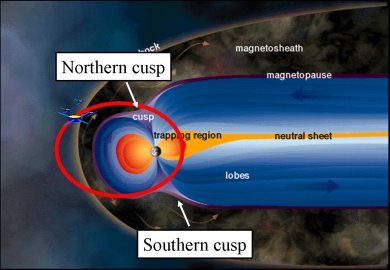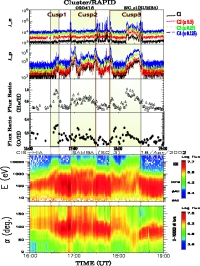Cluster Captures a Triple Cusp
13 May 2004
On 18 April 2002, three cusps were consecutively observed by Cluster over the northern hemisphere. A detailed study, published 14 May 2004 in Geophysical Research Letters, shows that this triple cusp was a temporal sequence rather than a spatial effect. This new discovery underlines the importance of the solar wind azimuthal and north/south flow as a dynamic driver of the cusp position.The northern cusp is a funnel-shaped opening in the Earth's magnetic field (see image below). An essential feature of this region can not be illustrated in this static sketch: its highly dynamic position and geometry.
 |
|
Cluster orbit over a sketch of the Earth's magnetosphere (Copyright ESA) |
In particular, apparent bifurcated cusp geometry (or double cusp) has been observed several times by Cluster - for example, over Greenland on 30 October 2001. Two possible explanations were proposed for this phenomenon: a temporal effect or a spatial effect.
A temporal effect occurs when the cusp location is shifted back and forth (for example under solar wind dynamic pressure). Related Cluster observations of cusp crossing look as if Cluster flies through the same cusp two times. Alternatively, the magnetic field can spatially bifurcate into two cusp-like regions, during periods of specific Interplanetary Magnetic Field (IMF) configuration.
The 14 May 2004 Zong et al. paper on this subject presents observational evidence that this triple cusp was a temporal sequence, and determines the main drivers of the cusp position for this event.
"The IMF influence on the cusp position has been known for some time", reminds Dr. Qiugang Zong, Co-Investigator of the Research with Adaptive Particle Imaging Detectors (RAPID) experiment and lead author on this research, published in Geophysical Research Letters. "But now we see that during certain conditions, like those encountered on 18 April 2002, the solar wind azimuthal flow can be the controlling factor of the cusp position and [...] a stronger factor than the IMF By/Bz components", he added.
This new discovery is expected to improve the modelling of the cusp position and geometry under various geomagnetic conditions (see animation below). "The importance of the solar wind azimuthal and north/south flow as a dynamic driver of the cusp, and even the whole magnetosphere has been [in the past] more or less neglected or underestimated", concludes Dr. Zong.
|
Animation of the response of the Earth's magnetosphere to changes of the solar wind components, similar to the windsock response. |
Zong, Q.-G., T. A. Fritz, H. Zhang, A. Korth, P. W. Daly, M. W. Dunlop, K.-H. Glassmeier, H. Reme, and A. Balogh (2004), Triple cusps observed by Cluster-Temporal or spatial effect?, Geophys. Res. Lett., 31, L, doi:10.1029/2003GL019128.
Contact
Qiugang Zong
Center for Space Physics
Boston University
MA
USA
Tel: +1-617-353-7448
3D animation
Qiugang Zong
Center for Space Physics
Boston University
MA
USA
Tel: +1-617-353-7448
Web story author
Arnaud Masson
SCI-SH division
RSSD
ESA
Noordwijk
The Netherlands
Tel: +31-71-565-5634
Web story editor
Philippe Escoubet
SCI-SH division
RSSD
ESA
Noordwijk
The Netherlands
Tel: +31-71-565-3454


